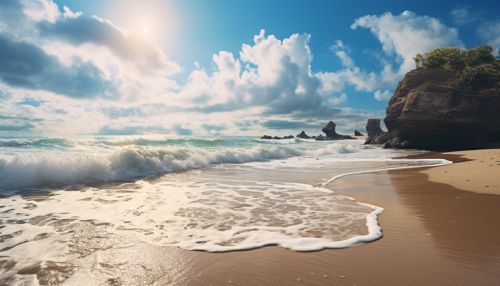Tides
Introduction
Tides are the rise and fall of sea levels caused by the combined effects of the gravitational forces exerted by the Moon and the Sun, and the rotation of the Earth. They are a complex global phenomenon that has been studied for centuries, and are of great importance to a variety of fields, including oceanography, geology, and marine biology.
Formation of Tides
Tides are formed as a result of the gravitational pull of the Moon and the Sun on the Earth's oceans. The Moon, being closer to the Earth, has a stronger gravitational pull and is primarily responsible for the formation of tides. This gravitational pull causes the water in the oceans to bulge out in the direction of the Moon. At the same time, another bulge occurs on the opposite side of the Earth, due to the Earth's rotation. These bulges are what we refer to as high tides.


Types of Tides
There are three basic types of tides: diurnal, semidiurnal, and mixed.
- Diurnal tides mean that there is one high tide and one low tide each day. These are most common in the Gulf of Mexico and Southeast Asia.
- Semidiurnal tides are characterized by two high tides and two low tides each day, of approximately the same height. These are most common along the east coast of the United States and the west coast of Europe.
- Mixed tides are characterized by two high tides and two low tides each day, but the heights of the tides differ. These are most common along the west coast of the United States.
Factors Influencing Tides
Several factors influence the height and timing of tides. These include the positions of the Moon and the Sun relative to the Earth, the shape of the coastline, and the depth and shape of the ocean floor. For example, when the Moon, Earth, and Sun are aligned (during a new moon or full moon), the combined gravitational pull results in higher than normal tides, known as spring tides. Conversely, when the Moon and Sun are at right angles to each other (during the first and third quarter moon), their gravitational pulls partially cancel each other out, resulting in lower than normal tides, known as neap tides.
Impact of Tides
Tides have a significant impact on the Earth's coastal environments. They influence the distribution of organisms in intertidal zones, affect coastal erosion and sedimentation processes, and play a role in the transport of pollutants and nutrients. In addition, tides are a source of renewable energy, and tidal energy technologies are being developed to harness this potential.
Tidal Predictions
The prediction of tides is a complex process that involves understanding the movements of the Moon and the Sun, as well as the physical characteristics of the oceans and coastlines. Tidal predictions are important for a variety of activities, including shipping, fishing, and coastal construction.
